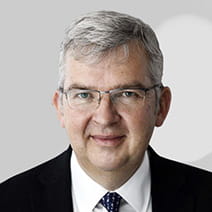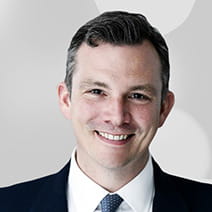John Husselbee explains in this video that even with interest rates now being reduced, the cost of capital will still be higher than over the past decade and why this will lead to greater rotation in equity markets.
SH: Hello, I'm Simon Hildrey and I'm with John Husselbee, Head of Multi-Asset at Liontrust. John, we've had a summer of increased volatility in markets, changing views on where we are with global growth. Can you tell us: are we in a pivotal moment and are things going to change from here?
JH: Yes, if we think about the economic story and the investment story (and I think investors always get the two confused; sometimes they work together, sometimes they work against each other), the economic story to date has been one of, inflation rising through Covid – it wasn't transitory, central banks had to act – and inflation's then come down.
In the meantime, despite high inflation, we haven't really had a major effect on the jobs market right around the world, particularly Western markets. Nor have we had a really big impact into the global economy either. So we've got a situation where inflation's coming down, jobs are normal, and interest rates probably have peaked and are coming back. Are they going to come back to that 0% to 2% range that we've seen over the last 10 to 15 years? I doubt it. I think we are going back to a normal situation where US terminal rates are probably about 3.5%. If we can think about rates going forward in the range of 3.5% - 4% in the US, then that means that we've got a cost of capital which is a lot higher than it was before. And what that really means is that for companies, sectors and countries, there'll be a rotation; there'll be something different to what has happened before.
SH: And how do you anticipate that? How do you position your funds and portfolios for that difference?
JH: I still think you need to be ‘risk on’. I still think you need to have equities in the portfolios. The last 10 to 15 years have seen a fairly concentrated portfolio. We can talk about concentration in the S&P a bit later, but it's been a concentrated portfolio on the basis that if you had a basket of US assets, starting just with dollars, and throw in some US treasuries and some US equities, putting those in a proportion that suits your risk appetite, you would have done a phenomenal job over the last 10 to 15 years.
With hindsight, if we went back 15 years and I was saying “Simon this is what we're going to do”, you'd go, “that's completely crazy”, because you don't typically put all your eggs in one basket. I think going forward you need further diversification into the portfolio. The earnings that we've seen in some of these large cap US stocks, which have been superior and therefore probably do deserve the [high] ratings, are now being seen in a broader context, not only in the US but stretching over international markets. Analysts are predicting by the end of the year or beginning of next year, the sorts of earnings you will see outside of those large cap stocks will be very similar, if not better, and they'll be at a cheaper price. Now, if you're a comparison shopper out there, which a lot of the market is, who wouldn't want growth of a similar magnitude to some of these Magnificent Seven stocks at cheaper prices? So, I think we will gradually start to see that rotation happen.
SH: When you talk about diversification, do you mean across investment styles, asset classes, and across different types of equities as well?
JH: I mean all of the above, but starting with geographically. You know diversification for us is always a given in terms of having a portfolio which will have equities, bonds, and maybe some non-traditional alternatives to cash in your portfolio. But going forward, I think that diversification, particularly in your equity basket geographically, I think you'll need that. And the beginning of August was a great fire drill in terms of what will happen when we see weaker returns from US large caps? What we saw was bonds working. So that's great news. You and I have talked about the 60/40 portfolio many times in terms of 'is it dead?' – I told you it wasn't dead, it's just been reloaded. And basically that worked. It was a fire drill. I suggest actually investors go back and look at the beginning of August. See what happened to your portfolio. And if you felt that you've had too much risk on board, you're taking too much of the downside, then there's still time to diversify your portfolio.
SH: Going back to that concentration risk, what does that mean in terms of your use of passives and actives on a relative basis against each other? Does it mean more tilt towards active?
JH: Yes. Let's just talk about the concentration risk and let's talk about it in the US equity market, which effectively is the biggest passive market as well. If you look at the top ten holdings in the S&P today, they represent 35% of the S&P. The last time we saw that concentration in the S&P, according to one of our US managers, you have to go back to the 1929 Great Depression & Wall Street Crash onwards till 1940 until the world recovered. I would say that market conditions back then were entirely different to what we have today. And therefore, it seems rather bizarre that just seven stocks are where all the growth is. I don't believe that, as I said – I think there is growth further away from that. But when you're looking at the S&P, its a market cap weighted index. That's how most people buy it in terms of passive. There are 500 stocks in it. They are mainly consumer stocks. There are financial stocks in there that represent the US economy. If you just took the equally weighted S&P – and there is an index out there – over the last five years, the market cap weighted has outperformed the equally weighted by some 40%. That's quite extraordinary.
What we've seen is the smaller sectors, like technology and some of these other service areas, have swollen to be much bigger than they were. That's where your risk in passive is. Passive has certainly helped us over the years in terms of a broader universe of options to put into the portfolio. However, I think there is a big opportunity for active management and that comes in mid and small caps.
The next investment story for me is rotation in the market. The investment story now is AI. AI is no doubt going to change the world, just like the internet did, just like railways and even my personal favorite: the light bulb. You know it will change the world in terms of productivity gains and economic growth. However, I think that has been played out to some extent as an investment story. That's the new economic story. And for me it's rotation into other parts of the equities world which is where you've got to be looking at for diversification going forward.
SH: And are you happy with how you arepositioned for that already? Or have you been making changes?
JH: Well, I think it's interesting. If we go back to the beginning of August, the VIX intraday goes through 60. The VIX is the index of fear and greed. As you know, as it goes up, the higher you see the fear in the market or the uncertainty in the market. We had the VIX hitting 65 intraday, which seemed crazy to me. The last time it hit 65 was during Covid, and the prior time was the Global Financial Crisis. I can understand the Global Financial Crisis: we didn't really know what the economy was going to do tomorrow. I can understand Covid; we really didn't know what the economy was going to do tomorrow. However, at the beginning of August, I couldn't see how anything had changed too much. We knew that the US economy was slowing down. We knew at some point, the yen is going to basically weaken and the central bank, the Bank of Japan, was going to put up interest rates. And when they did by 25 basis points, it was a major headline. It was sentiment driven. What you have to do in investment is really just work upon the signal. The signal is the fundamentals. There had been no changes in the fundamentals. If there's no change in the fundamentals, stick with your portfolio and let compounding do the work.
SH Great. Thank you, John. And thank you for watching. We'll see you next time.
KEY RISKS
Past performance is not a guide to future performance. The value of an investment and the income generated from it can fall as well as rise and is not guaranteed. You may get back less than you originally invested.
The issue of units/shares in Liontrust Funds may be subject to an initial charge, which will have an impact on the realisable value of the investment, particularly in the short term. Investments should always be considered as long term.
The Funds and Model Portfolios managed by the Multi-Asset Team may be exposed to the following risks:
Credit Risk: There is a risk that an investment will fail to make required payments and this may reduce the income paid to the fund, or its capital value. The creditworthiness of a bond issuer may also affect that bond's value. Bonds that produce a higher level of income usually also carry greater risk as such bond issuers may have difficulty in paying their debts. The value of a bond would be significantly affected if the issuer either refused to pay or was unable to pay; Counterparty Risk: The insolvency of any institutions providing services such as safekeeping of assets or acting as counterparty to derivatives or other instruments, may expose the Fund to financial loss; Liquidity Risk: If underlying funds suspend or defer the payment of redemption proceeds, the Fund's ability to meet redemption requests may also be affected; Interest Rate Risk: Fluctuations in interest rates may affect the value of the Fund and your investment. Bonds are affected by changes in interest rates and their value and the income they generate can rise or fall as a result; Derivatives Risk: Some of the underlying funds may invest in derivatives, which can, in some circumstances, create wider fluctuations in their prices over time; Emerging Markets: The Fund may invest in less economically developed markets (emerging markets) which can involve greater risks than well developed economies; Currency Risk: The Fund invests in overseas markets and the value of the Fund may fall or rise as a result of changes in exchange rates. Index Tracking Risk: The performance of any passive funds used may not exactly track that of their Indices. Any performance shown in respect of the Model Portfolios are periodically restructured and/or rebalanced. Actual returns may vary from the model returns.
The risks detailed above are reflective of the full range of Funds managed by the Multi-Asset Team and not all of the risks listed are applicable to each individual Fund. For the risks associated with an individual Fund, please refer to its Key Investor Information Document (KIID)/PRIIP KID.
DISCLAIMER
This is a marketing communication. Before making an investment, you should read the relevant Prospectus and the Key Investor Information Document (KIID), which provide full product details including investment charges and risks. These documents can be obtained, free of charge, from www.liontrust.co.uk or direct from Liontrust. Always research your own investments. If you are not a professional investor please consult a regulated financial adviser regarding the suitability of such an investment for you and your personal circumstances.
This should not be construed as advice for investment in any product or security mentioned, an offer to buy or sell units/shares of Funds mentioned, or a solicitation to purchase securities in any company or investment product. Examples of stocks are provided for general information only to demonstrate our investment philosophy. The investment being promoted is for units in a fund, not directly in the underlying assets. It contains information and analysis that is believed to be accurate at the time of publication, but is subject to change without notice. Whilst care has been taken in compiling the content of this document, no representation or warranty, express or implied, is made by Liontrust as to its accuracy or completeness, including for external sources (which may have been used) which have not been verified. It should not be copied, forwarded, reproduced, divulged or otherwise distributed in any form whether by way of fax, email, oral or otherwise, in whole or in part without the express and prior written consent of Liontrust.











